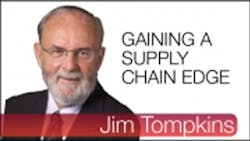Who Are Today's 'Titans' and 'Industry Leaders' in Omnichannel? -- Part 1
In today’s omnichannel world, there are four types of supply chains. You can either be a titan, industry leader, player, or laggard.
In this new two-part series, I’ll share in-depth profiles of these four key categories—how they operate, their priorities, and what you need to know about them. Understanding their profiles gives you an advantage. Not only you can you see which category you fall under, but you can also discover which category your competitors are in.
First, let’s look at the titans. Titans understand that channels are an invention of retailers and consumer products companies, and that customers do not see channels. As a result, today’s titans do not see channels.
They have inventories throughout the supply chain that are physically and logically visible. Their inventories are available for any customer—anytime and anywhere. Titans believe customers should define delivery parameters and that it is their job as a titan to respond.
We also know that their order management system is focused on meeting customers’ delivery parameters. Their integrated business planning is supported by a demand-driven supply chain that supports the synchronization of supply to demand. The titans have a high degree of supply chain adaptability that supports a responsive supply chain.
How about industry leaders? While channels focus on offering customers a uniform view of the company, the channels do exist and operate unto themselves. Omnichannel is not about combining channels, but rather about building enough interfaces so that the channels appear to be operating as one.
Industry leaders have inventories throughout the company’s supply chain that are logically linked to be available for any customer at any time and location. They believe customers should decide what excellent delivery parameters are and execute according to these parameters.
Their order management systems allow for achieving great customer delivery at a minimum cost. Sales inventory operations planning (SIOP) is done well and significant progress has been made on high inventory turns and low product mark downs. A high degree of organizational adaptability supports an organization’s ability to respond to marketplace gyrations.
Coming up next week in part 2 of this series, I’ll place a spotlight on the players and laggards of today’s omnichannel supply chain. How do they view their customers? What are their strengths and weaknesses?
And the most important question to consider: which of the four categories do you fall under?
About the Author
Jim Tompkins
CEO
|
Dr. James A. Tompkins is an international authority on leadership, logistics, material handling, outsourcing, and supply chain best practices. As the founder and CEO of Tompkins International, he provides leadership for Tompkins globally. His 30-plus years as CEO of a consulting / integration firm and his focus on helping companies achieve profitable growth give him an insider’s view into what makes great companies even better. Listen to an interview of Jim Tompkins on the Business Leader Radio show. As a high-level business advisor, his unique perspective prepares corporations and executives for the future. To share his knowledge and provide up-to-date information on supply chain and business trends, he developed the GoGoGo! Blogand Global Supply Chain Podcast. He has written or contributed to more than 30 books and eBooks, including Caught Between the Tiger and the Dragon, Bold Leadership, Logistics and Manufacturing Outsourcing, The Supply Chain Handbook, andNo Boundaries. Jim has been quoted in hundreds of business and industry magazines such as The Journal of Commerce, Supply & Demand Chain Executive, and FORTUNE, and he has spoken at more than 4,000 international engagements. Jim has served as President of the Institute of Industrial Engineers, the Materials Management Society, and the College-Industry Council on Material Handling Education, and Purdue has named him a Distinguished Engineering Alum. He has also received more than 50 awards for his service to his profession. |
